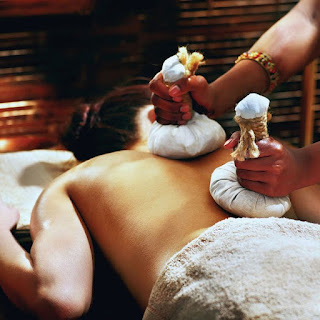Ayurvedic massage benefits -self massage at home methods!
What is the Ayurvedic massage?
Ayurvedic massage blends pressure points with the 5,000-year-old Indian concepts of Ayurveda—the science of life. This style of massage is to help the body recover itself by restoring equilibrium to the mind, aging body, and soul. Because it often combines warm herb essential oils, as well as time-honored and non-traditional strokes and kneading, it's also referred to as an "oil massage."
What are the advantages of getting an ayurvedic massage?
An Ayurveda massage helps cleanse and invigorate the body by improving circulation, stimulating and strengthening the lymphatic system, and opening the flow of life energy.
Here's how to do an abhyanga self-massage in general:
Fill a clean, empty shampoo or squeeze bottle halfway with oil. Use the oil all over your body, including the top of your head. Proceed to your brow, ears, cheeks, and jawline. Moving in clockwise and circular strokes, massage your chest and belly.
When it comes to self-massage, how often should you do it?
We recommend massage slowly for 5-10 minutes a day, focusing on 30-60 seconds muscle trigger points. Apply pressure, but don't be overly harsh so that the tissue loosens rather than bruises.
Be careful when massaging these parts.
Because of the structures beneath, deep, persistent pressure should be avoided in these parts of the body. The neck, the spinal column, the umbilical area, should not be massaged very hardly..
Is it acceptable to get a massage every day?
Is getting a massage every day bad? You can safely have a relaxation massage twice a day – one in the morning and once at night – for general wellness and relaxation! With targeted massage therapy sessions that are less frequent, muscle pain reduction can take some time when treating chronic disease.
Is a 30-minute massage worth it?
You want a very focused massage. If you only require a 30-minute massage for a specific location, such as your shoulders, lower back, hips, or arms, a 30-minute massage is your best bet. A massage can be beneficial to any age, especially if they are athletes. Massage gives skin shine and hydrating healthy skin.
Is it common to have a lot of bowel movements following a massage?
Massage reduces your respiration and circulation rate, lowers your blood pressure, and restarts your digestion (the repetitive strokes on the lower torso also help stimulate the large intestine). That is why, after a massage, you may have frequent bowel movements.
Which massage is the most effective for relieving stress?
Shiatsu massage helps to unwind and remove stress, discomfort, and tension.
After a massage, what happens to your body?
After a massage, it's normal to feel sore. It transports blood and nutrition to your muscles while also removing pollutants. You may suffer delayed onset muscular soreness after activating muscles you don't normally utilize. As your body recovers, this is a physical response to the inflammation.
Why do massages hurt yet make you feel better?
Massage helps relieve the accumulation and boost blood flow, bringing oxygen to the muscle regions that hadn't been getting enough before. That is why some back and shoulder massages can be excruciatingly painful.
Is it possible for a poor massage to cause nerve damage?
Nerve injury is not a common side effect of massage, but consumers and therapists should be aware of the possibility. Massage therapists should avoid applying excessive focused pressure to the neck and shoulder area to decrease the risk of nerve injury.
Which oil is good for massage?
Coconut oil, safflower oil, castor oil, mustard oil, and neem oil are widely used in Ayurvedic massage and referenced in the classic literature. These oils also have unique characteristics. For hot Pitta types, coconut oil is cooling and can used for abhyanga throughout the summer months. You can add vitamin capsules also to this oil if you want.


